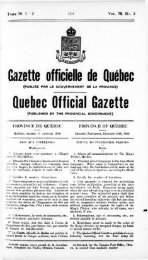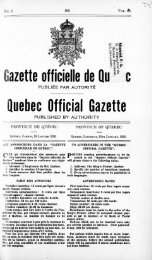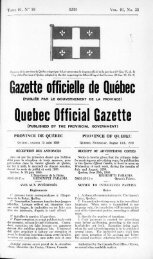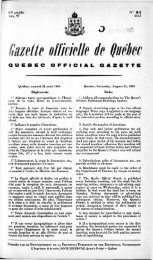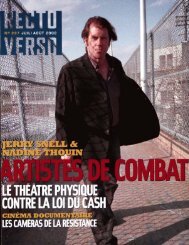kzetie officielle de Québec
kzetie officielle de Québec
kzetie officielle de Québec
- No tags were found...
Create successful ePaper yourself
Turn your PDF publications into a flip-book with our unique Google optimized e-Paper software.
QUEBEC OFFICIAL GAZETTE, July JO, 1900, Vol. 98, No. 80<br />
Le stagiaire doit porter une toge noire et un<br />
babil foncé.<br />
12° Pendant les séances avec enquête, les<br />
greffiers, liuissiers-audienciers et autres officiers<br />
.1, la Cour doivent porter la toge appropriée à<br />
leur fonction, une chemise blanche avec cravate<br />
foncée «'t 1,11<br />
pantalon sombre.<br />
13* Le protonotaire dresse un procès-verbal<br />
d'audience où il note toutes les productions<br />
faites pendant les séances, toutes les Ordonnances<br />
du Tribunal et toutes les décisions inci<strong>de</strong>ntes<br />
Kans délibéré, excepté celles relatives à la preuve<br />
qui sont notées dans les dépositions; il rédige<br />
aussi et fait signer par les parties ou leurs avocats<br />
les admissions (pli lui sont dictées et note<br />
celles qui sont dictées au sténographe officiel.<br />
11° Le protonotaire, pendant l'audience,<br />
dresse les inventaires <strong>de</strong> production, en cotant<br />
les pièces par la lettre et la suite <strong>de</strong>s numéros<br />
déjà employés. Si les pièces cotées ne sont pas<br />
produites, il le mentionne sur l'inventaire, L'enquête<br />
terminée, il fait certifier l'inventaire par<br />
chaque partie ou son procureur.<br />
15° Tout officier <strong>de</strong> la Cour, exerçant à l'audience<br />
quelque fonction <strong>de</strong> son état, y assiste à<br />
sa place, <strong>de</strong>puis l'ouverture <strong>de</strong> la Cour jusqu'à<br />
l'ajournement.<br />
10° La lecture <strong>de</strong>s journaux et la prise <strong>de</strong><br />
photographies sont interdites à l'audience.<br />
Des<br />
CHAPITRE V<br />
sténographes<br />
17° Chaque sténographe est tenu <strong>de</strong> se rendre<br />
dans la salle d'audience où il doit remplir ses<br />
fonctions, ù l'heure d'ouverture <strong>de</strong> la séance et y<br />
rester tant qu'il ne sera pas libéré par le juge.<br />
18 Le protonotaire doit faire rapport au juge<br />
en chef lorsqu'une cause n'a pas procédé parce<br />
qu'il n'y avait pas <strong>de</strong> sténographe officiel et<br />
donner la raison <strong>de</strong> cette absence s'il la connaît.<br />
1!»° Le sténographe est tenu d'enregistrer les<br />
dépositions, les admissions qui lui sont dictées,<br />
les objections à la preuve et les décisions sur<br />
ieelles. S'il en est requis par le juge, il enregistre<br />
aussi les plaidoiries sur les objections.<br />
1* sténographe qui reçoit l'ordre <strong>de</strong> traduire à<br />
la l'ois plus d'une déposition dans la même cause<br />
ne peut faire taxer qu'une fois le titre <strong>de</strong> la cause<br />
et le certificat <strong>de</strong> traduction. Chacune <strong>de</strong>s pages<br />
"ù se trouve reproduite une déposition porte,<br />
en ligne <strong>de</strong> tête, le nom du témoin. Le sténographe<br />
doit conserver ses notes à l'endroit indiqué<br />
par le protonotuire.<br />
CHAPITRE VI<br />
Des jugements et délibérés<br />
20° Avant <strong>de</strong> le remettre au juge, le protonolaire<br />
s'assure que le dossier contient, numérotés<br />
au jour le jour suivant la date <strong>de</strong> leur production,<br />
'es actes <strong>de</strong> procédure, les pièces, les interloculoires<br />
et les interrogatoires faits hors <strong>de</strong> Cour,<br />
<strong>de</strong> même que les ménoires exigés par la Cour. Si<br />
le dossier est incomplet, il en avertit les procureurs<br />
afin qu'ils y pourvoient.<br />
Aucune cause ne sera « en délibéré » et aucun<br />
dossier ne sera transmis au juge tant qu'il<br />
n aura pas été ainsi complété, ù moins que le<br />
juge n'en déci<strong>de</strong> autrement.<br />
Stu<strong>de</strong>nts shall wear black gown and dark suit.<br />
12. During sessions of the Court when proof<br />
is ma<strong>de</strong>, clerks, criers and other officers of the<br />
Court shall wear the gown appropriate to their<br />
office, white shirt, dark tie and dark trousers.<br />
13. The prothonotary draws up the minutes<br />
(procès-verbal) of the bearing in which he makes<br />
mention of everything produced during the<br />
sessions, all the or<strong>de</strong>rs of the Court and all the<br />
inci<strong>de</strong>ntal <strong>de</strong>cisions ren<strong>de</strong>red without being<br />
taken un<strong>de</strong>r advisement, except those concerning<br />
the proof which have been recor<strong>de</strong>d in the <strong>de</strong>positions;<br />
he also draws up and has signed by the<br />
parties or their attorneys the admissions which<br />
are dictated to him and mentions those which<br />
are dictated to the official stenographer.<br />
14. The prothonotary, during the bearing,<br />
draws up a list of exhibits marking the exhibits<br />
by the letter and following the numbers already<br />
employed. If the exhibits marked are not produced,<br />
he mentions it on the list. At the close<br />
of the trial, he has the list certified by each party<br />
or his attorney.<br />
15. Every officer of the Court exercising his<br />
functions before the Court in session attends<br />
in his place from the opening to the adjournment<br />
of the Court.<br />
16. The reading of newspapers and the taking<br />
of photographs is forbid<strong>de</strong>n during the sittings<br />
of the Court.<br />
CHAPTER<br />
Stenographers<br />
17. Every stenographer is obliged to proceed to<br />
the Court room at which he is to fulfill his duties,<br />
and be present at the opening of the session<br />
and remain there until freed by the Judge.<br />
18. The prothonotary makes a report to the<br />
Chief Justice when the case has not procee<strong>de</strong>d<br />
because of the lack of the services of an official<br />
stenographer and states the reason for this lack,<br />
if it is known to him.<br />
19. The stenographer must take the <strong>de</strong>positions,<br />
the admissions which are dictated to him,<br />
the objections to the evi<strong>de</strong>nce, and the <strong>de</strong>cisions<br />
thereon. If the Judge so requires, he also takes<br />
the argument upon the objections.<br />
The stenographer who is or<strong>de</strong>red to transcribe<br />
at the same time more than one <strong>de</strong>position in the<br />
same case can only once tax the title of the case<br />
and the certificate of transcription. Each of the<br />
pages upon which the <strong>de</strong>position is reproduced<br />
mentions, at the top thereof, the name of the<br />
witness. The stenographer must preserve his<br />
notes at the place fixed by the prothonotary.<br />
V<br />
CHAPTER VI<br />
Judgments and Cases un<strong>de</strong>r Advisement<br />
20. Before sending it to the Judge, the prothonotary<br />
assures himself that the record contains<br />
the proceedings, exhibits, interlocutory proceedings<br />
and interrogatories taken out of Court,<br />
numbered day by day according to the date of<br />
their production as well as the notes required<br />
by the Court. If the record is incomplete, he<br />
notifies the attorneys in or<strong>de</strong>r that they may<br />
complete it.<br />
No case will be "en délibéré" and no record<br />
sent to the Judge until it has been completed.



